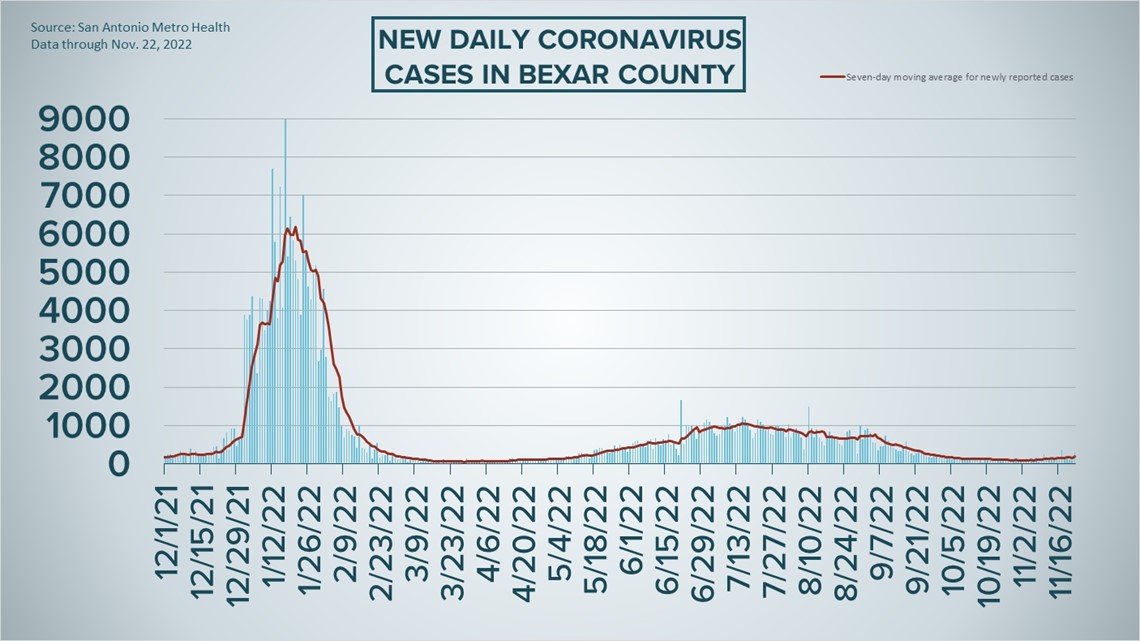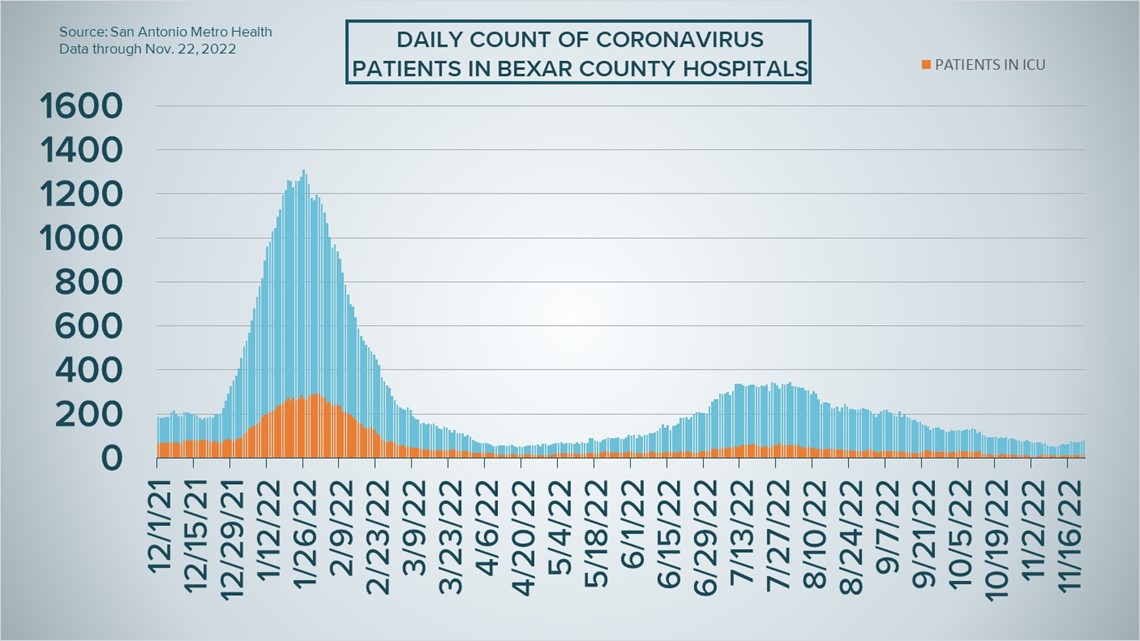SAN ANTONIO — For the first time since the summer months, key COVID-19 numbers are trending in the wrong direction in San Antonio as families prepare to gather for the Thanksgiving holiday.
Metro Health officials reported 284 new infections Tuesday, the highest single-day count of the last two months and a figure that brings the seven-day case average to 185, the highest that number has been since Oct. 2. Meanwhile, November has yielded an average of 141 cases a day so far, putting it on track for the first month-to-month rise in infections since July.
Bexar County's coronavirus risk level is still "low," but Metro Health says the situation is also "worsening" for the first time since July's omicron surge.
The key indicator of note is hospitalizations, and those too have steadily risen this month. On Tuesday there were 77 patients receiving treatment for coronavirus symptoms in local hospitals, up 30% from a week ago. It's also the most hospitalizations of any day this month.
But the trend hasn't overtaxed health care workers just yet. Metro Health said new hospital admissions and case rates remain low compared to the July surge (for comparison, there were 327 patients on July 22, or more than four times as many as Tuesday).
Metro Health continues to organize pop-up vaccine clinics for anyone still needing COVID-19 or flu shots, though there's only one chance to get a no-cost shot this week – on Saturday afternoon – due to the holiday.
More than 653,000 COVID-19 diagnoses have been reported in Bexar County since the pandemic began, though that number likely doesn't include thousands of at-home tests that went unreported to Metro Health. At least 5,421 residents have died from virus complications.
How Bexar County is trending




Vaccine progress in Bexar County
The following numbers are provided by San Antonio Metro Health. A full breakdown can be found here.
- 1,481,332 eligible Bexar County residents are fully vaccinated as of Oct. 10, which is about 74% of the total population over 6 months old.
- 591,339 eligible Bexar County residents have received a COVID-19 booster shot as of Oct. 10, which is 40% percent of the population over 4 years old.
The CDC states that "when a high percentage of the community is immune to a disease (through vaccination and/or prior illness)," that community will have reached herd immunity, "making the spread of this disease from person to person unlikely."
The City of San Antonio breaks down the vaccination rates by zip code on Metro Health's Vaccination Statistics page.
Coronavirus in Texas
The total number of coronavirus cases in the state grew by 1,229 on Monday, according to the Texas Department of State Health Services. That total includes 854 new confirmed cases and 375 new probable cases. More details can be found on this page. Figures for Tuesday have not yet been reported.
Monday's figures bring the total number of Texans diagnosed with COVID-19 to more than 7.96 million.
Meanwhile, there were no newly reported virus-related deaths in Texas, the state reported Monday. The statewide death toll stands at 89,697.
Coronavirus symptoms
The symptoms of coronavirus can be similar to the flu or a bad cold. Symptoms include fever or chills, cough, shortness of breath or difficulty breathing, fatigue, muscle or body aches, headache, new loss of taste or smell sore throat, congestion or runny nose, nausea or vomiting, and diarrhea, according to the Centers for Disease Control.
Most healthy people will have mild symptoms. A study of more than 72,000 patients by the Centers for Disease Control in China showed 80 percent of the cases there were mild.
But infections can cause pneumonia, severe acute respiratory syndrome, kidney failure, and even death, according to the World Health Organization. Older people with underlying health conditions are most at risk.
Experts determined there was consistent evidence these conditions increase a person's risk, regardless of age:
- Chronic kidney disease
- COPD (chronic obstructive pulmonary disease)
- Obesity (BMI of 30 or higher)
- Immunocompromised state (weakened immune system) from solid organ transplant
- Serious heart conditions, such as heart failure, coronary artery disease, or cardiomyopathies
- Sickle cell disease
- Type 2 diabetes
- The CDC believes symptoms may appear anywhere from two to 14 days after being exposed.
Human coronaviruses are usually spread...
- Between people who are in close contact with one another (within about 6 feet).
- Through respiratory droplets produced when an infected person coughs, sneezes or talks. These droplets can land in the mouths or noses of people who are nearby or possibly be inhaled into the lungs.
- Some recent studies have suggested that COVID-19 may be spread by people who are not showing symptoms.
Help stop the spread of coronavirus
- Stay home when you are sick.
- Eat and sleep separately from your family members
- Use different utensils and dishes
- Cover your cough or sneeze with your arm, not your hand.
- If you use a tissue, throw it in the trash.
Find a testing location
City officials recommend getting a COVID-19 test if you experience fever or chills, cough, shortness of breath or difficulty breathing, fatigue, muscle or body aches, headache, new loss of taste or smell, sore throat, congestion or runny nose, nausea or vomiting, or diarrhea.
Here's a Testing Sites Locator to help you find the testing location closest to you in San Antonio.

